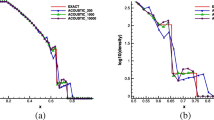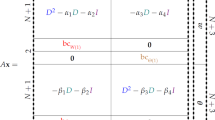Abstract
In computational fluid dynamics (CFD), the Riemann problem is vital for precise fluid flow calculations as it involves the accurate computation of the interactions between different states of fluid flow. Approximate non-iterative Riemann solvers are commonly used for efficiency but introduce errors in complex cases. An exact Riemann solver offers higher accuracy by directly solving the problem without approximations or simplifications. However, it involves nonlinear equations, leading to iterative methods. To promote the use of exact solver, an efficient non-iterative multi-point (NIM) method is proposed to solve the Riemann problem as it has a convergence order of \(\frac{1}{\sqrt 2 }\left[ {(1 + \sqrt 2 )^{n - 1} - (1 - \sqrt 2 )^{n - 1} } \right]\), which exceeds the theoretical limit of \(2^{n - 1}\) and thereby disproving the almost 50-year-old Kung–Traub conjecture. As the conjecture has always served as a basis for designing optimal algorithms to solve nonlinear equations, this finding is crucial as it implies the potential to devise substantially faster algorithms, which could find practical applications in engineering fields such as CFD, as demonstrated in this paper.







Similar content being viewed by others
Data availability
The data that support the findings of this study are available from the corresponding author upon reasonable request.
References
LeVeque, R. J.: Finite volume methods for hyperbolic problems. Cambridge university press, Cambridge, vol. 31 (2002). https://doi.org/10.1017/CBO9780511791253.
Cockburn, B., Karniadakis, G. E., Shu, C.-W.: Discontinuous Galerkin methods: theory, computation and applications. Springer, Berlin, vol. 11 (2012). https://doi.org/10.1007/978-3-642-59721-3.
Hesthaven, J. S., Warburton, T.: Nodal discontinuous Galerkin methods: algorithms, analysis, and applications. Springer, New York (2007). https://doi.org/10.1007/978-0-387-72067-8.
Miller, S., Abedi, R.: Riemann solutions for spacetime discontinuous Galerkin methods. J. Comput. Appl. Math. 270, 510–521 (2014). https://doi.org/10.1016/j.cam.2013.11.027
Harten, A., Lax, P. D., van Leer, B.: On upstream differencing and Godunov-type schemes for hyperbolic conservation laws. In: Hussaini, M.Y., van Leer, B., Van Rosendale, J. (eds) Upwind and high-resolution schemes. Springer, Heidelberg (1997). https://doi.org/10.1007/978-3-642-60543-7_4
Toro, E.F., Spruce, M., Speares, W.: Restoration of the contact surface in the HLL-Riemann solver. Shock Waves 4(1), 25–34 (1994). https://doi.org/10.1007/BF01414629
Roe, P.: Approximate Riemann solvers, parameter vectors, and difference schemes. J. Comput. Phys. 43(2), 357–372 (1981). https://doi.org/10.1016/0021-9991(81)90128-5
Magiera, J., Ray, D., Hesthaven, J.S., Rohde, C.: Constraint-aware neural networks for Riemann problems. J. Comput. Phys. 409, 109345 (2020). https://doi.org/10.1016/j.jcp.2020.109345
Wang, J.: Riemann solvers with non-ideal thermodynamics: exact, approximate, and machine learning solutions. Ph.D. dissertation, UWSpace (2022). http://hdl.handle.net/10012/18778. Accessed 5 June 2023.
Ruggeri, M., Roy, I., Mueterthies, M.J., Gruenwald, T., Scalo, C.: Neural-network-based Riemann solver for real fluids and high explosives; application to computational fluid dynamics. Phys. Fluids 34(11), 116121 (2022). https://doi.org/10.1063/5.0123466
Wang, J.C.-H., Hickey, J.-P.: Fluxnet: a physics-informed learning-based Riemann solver for transcritical flows with non-ideal thermodynamics. Comput. Methods Appl. Mech. Eng. 411, 116070 (2023). https://doi.org/10.1016/j.cma.2023.116070
Colella, P., Glaz, H.M.: Efficient solution algorithms for the Riemann problem for real gases. J. Comput. Phys. 59(2), 264–289 (1985). https://doi.org/10.1016/0021-9991(85)90146-9
Hirota equation W.-Q. Peng, Chen, Y.: N-double poles solutions for nonlocal with nonzero boundary conditions using Riemann–Hilbert method and PINN algorithm. Phys. D: Nonlinear Phenomena. 435, 133274 (2022). https://doi.org/10.1016/j.physd.2022.133274.
Peng, W.-Q., Chen, Y.: Double and triple pole solutions for the Gerdjikov-Ivanov type of derivative nonlinear Schr dinger equation with zero/nonzero boundary conditions. J. Math. Phys. 63(3), 033502 (2022). https://doi.org/10.1063/5.0061807
Zeng, S., Liu, Y.: The Whitham modulation solution of the complex modified KdV equation. Mathematics 11(13), 2810 (2023). https://doi.org/10.3390/math11132810
El, G., Geogjaev, V., Gurevich, A., Krylov, A.: Decay of an initial discontinuity in the defocusing NLS hydrodynamics. Phys. D 87(1), 186–192 (1995). https://doi.org/10.1016/0167-2789(95)00147-V
Zhu, J.-Y., Chen, Y.: Long-time asymptotic behavior of the coupled dispersive AB system in low regularity spaces. J. Math. Phys. 63(11), 113504 (2022). https://doi.org/10.1063/5.0102264
Liu, Y., Wang, D.-S.: Exotic wave patterns in Riemann problem of the high-order Jaulent-Miodek equation: Whitham modulation theory. Stud. Appl. Math. 149(3), 588–630 (2022). https://doi.org/10.1111/sapm.12513
Kamchatnov, A.M.: Evolution of initial discontinuities in the DNLS equation theory. J. Phys. Commun. 2(2), 025027 (2018). https://doi.org/10.1088/2399-6528/aaae12
Ivanov, S.K.: Riemann problem for the light pulses in optical fibers for the generalized Chen-Lee-Liu equation. Phys. Rev. A 101, 053827 (2020). https://doi.org/10.1103/PhysRevA.101.053827
Zhu, J.-Y., Chen, Y.: A new form of general soliton solutions and multiple zeros solutions for a higher-order Kaup-Newell equation. J. Math. Phys. 62(12), 123501 (2021). https://doi.org/10.1063/5.0064411
Chong, C., Herrmann, M., Kevrekidis, P.: Dispersive shock waves in lattices: a dimension reduction approach. Physica D 442, 133533 (2022). https://doi.org/10.1016/j.physd.2022.133533
Kung, H.T., Traub, J.F.: Optimal order of one-point and multipoint iteration. J. ACM 21(4), 643–651 (1974). https://doi.org/10.1145/321850.321860
Behl, R., Cordero, A., Motsa, S.S., Torregrosa, J.R.: Multiplicity anomalies of an optimal fourth-order class of iterative methods for solving nonlinear equations. Nonlinear Dyn. 91(1), 81–112 (2018). https://doi.org/10.1007/s11071-017-3858-6
Behl, R., Alshomrani, A.S., Motsa, S.S.: An optimal scheme for multiple roots of nonlinear equations with eighth-order convergence. J. Math. Chem. 56(7), 2069–2084 (2018). https://doi.org/10.1007/s10910-018-0857-x
Zafar, F., Cordero, A., Junjua, M.-U.-D., Torregrosa, J.R.: “Optimal eighth-order iterative methods for approximating multiple zeros of nonlinear functions,” Revista de la Real Academia de Ciencias Exactas. Físicas y Naturales. Serie A. Matemáticas 114(2), 64 (2020). https://doi.org/10.1007/s13398-020-00794-7
Panday, S., Sharma, A., Thangkhenpau, G.: Optimal fourth and eighth-order iterative methods for non-linear equations. J. Appl. Math. Comput. 69(1), 953–971 (2023). https://doi.org/10.1007/s12190-022-01775-2
Naber, J.: Building Your Own Shock Tube. ser. Modelling, Analysis and Simulation (MAS). Amsterdam, Netherlands: Stichting Centrum voor Wiskunde en Informatica, 2005, https://ir.cwi.nl/pub/10964. Accessed 5 June 2023.
Chen, X.-D., Shi, J., Ma, W.: A fast and robust method for computing real roots of nonlinear equations. Appl. Math. Lett. 68, 27–32 (2017). https://doi.org/10.1016/j.aml.2016.12.013
Davis, P.J.: Interpolation and Approximation. Blaisdell Pub. Company, New York (1963)
Habgood, K., Arel, I.: A condensation-based application of Cramers rule for solving large-scale linear systems. J. Discrete Algorithms 10, 98–109 (2012). https://doi.org/10.1016/j.jda.2011.06.007
Anderson, E., Bai, Z., Bischof, C., Blackford, S., Demmel, J., Dongarra, J., Du Croz, J., Greenbaum, A., Hammarling, S., McKenney, A., Sorensen, D.: LAPACK Users' Guide, 3rd edn. Philadelphia: Society for Industrial and Applied Mathematics, 1999. https://www.netlib.org/lapack/lug/. Accessed 5 June 2023.
Chen, X.-D., Zhang, Y., Shi, J., Wang, Y.: An efficient method based on progressive interpolation for solving non-linear equations. Appl. Math. Lett. 61, 67–72 (2016). https://doi.org/10.1016/j.aml.2016.05.007
Berthon, C.: Why the MUSCL-Hancock scheme is L1-stable. Numer. Math. 104, 27–46 (2006). https://doi.org/10.1007/s00211-006-0007-4
Koren, B.: A robust upwind discretization method for advection, diffusion and source terms. In: C. B. Vreugdenhil, B. Koren (Eds.), Numerical Methods for Advection-Diffusion Problems, pp. 117–138. Vieweg (1993)
Sod, G.A.: A survey of several finite difference methods for systems of nonlinear hyperbolic conservation laws. J. Comput. Phys. 27(1), 1–31 (1978). https://doi.org/10.1016/0021-9991(78)90023-2
Einfeldt, B., Munz, C., Roe, P., Sjögreen, B.: On Godunov-type methods near low densities. J. Comput. Phys. 92(2), 273–295 (1991). https://doi.org/10.1016/0021-9991(91)90211-3
Woodward, P., Colella, P.: The numerical simulation of two-dimensional fluid flow with strong shocks. J. Comput. Phys. 54(1), 115–173 (1984). https://doi.org/10.1016/0021-9991(84)90142-6
Toro, E.F.: Riemann solvers and numerical methods for fluid dynamics: a practical introduction. Springer, Berlin (2009). https://doi.org/10.1007/b79761.
Funding
The authors declare that no funds, grants, or other support were received during the preparation of this manuscript.
Author information
Authors and Affiliations
Corresponding author
Ethics declarations
Conflict of interests
The authors have no relevant financial or non-financial interests to disclose.
Additional information
Publisher's Note
Springer Nature remains neutral with regard to jurisdictional claims in published maps and institutional affiliations.
Rights and permissions
Springer Nature or its licensor (e.g. a society or other partner) holds exclusive rights to this article under a publishing agreement with the author(s) or other rightsholder(s); author self-archiving of the accepted manuscript version of this article is solely governed by the terms of such publishing agreement and applicable law.
About this article
Cite this article
Toh, Y.H. Efficient non-iterative multi-point method for solving the Riemann problem. Nonlinear Dyn 112, 5439–5451 (2024). https://doi.org/10.1007/s11071-023-09229-5
Received:
Accepted:
Published:
Issue Date:
DOI: https://doi.org/10.1007/s11071-023-09229-5




